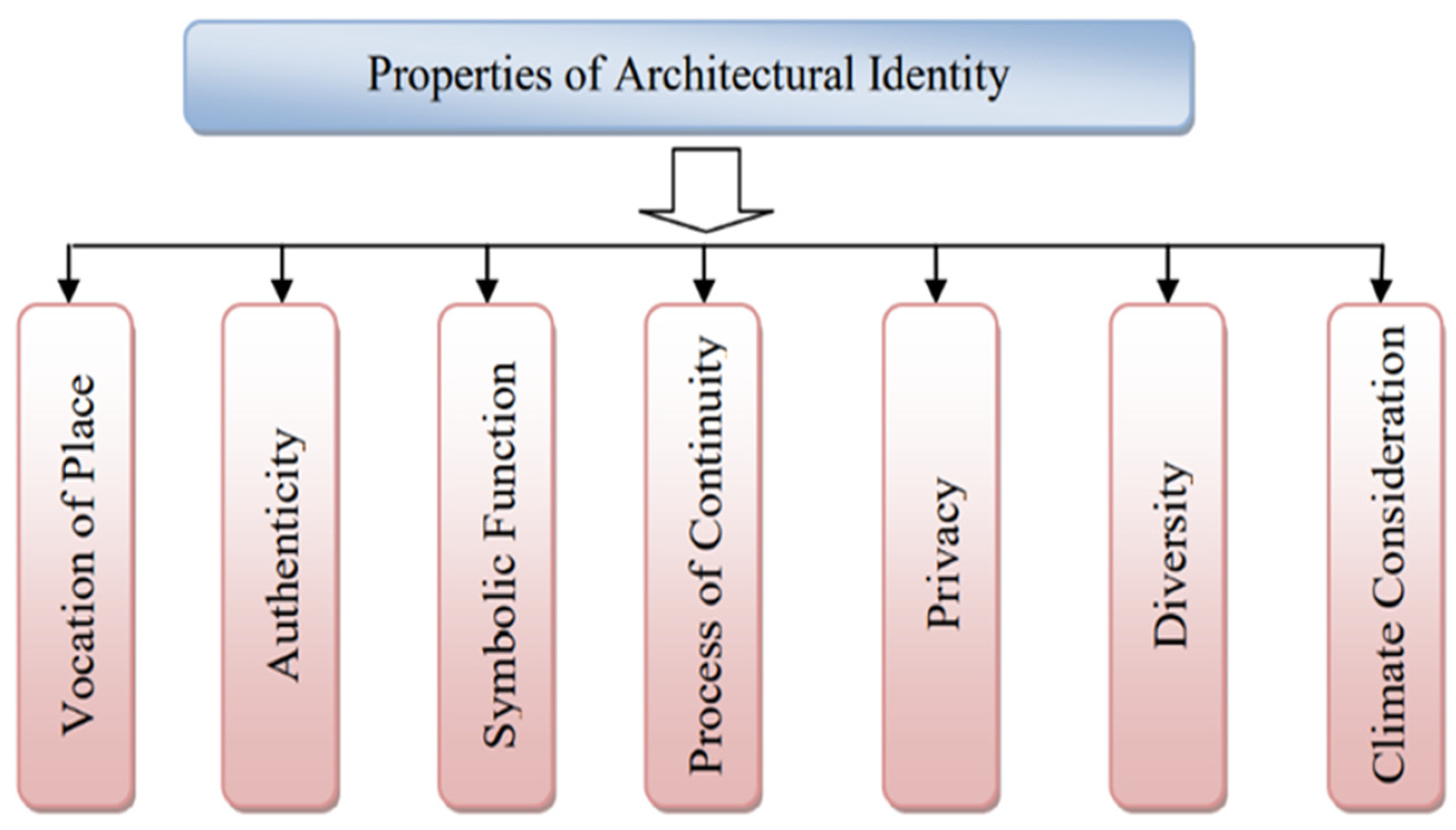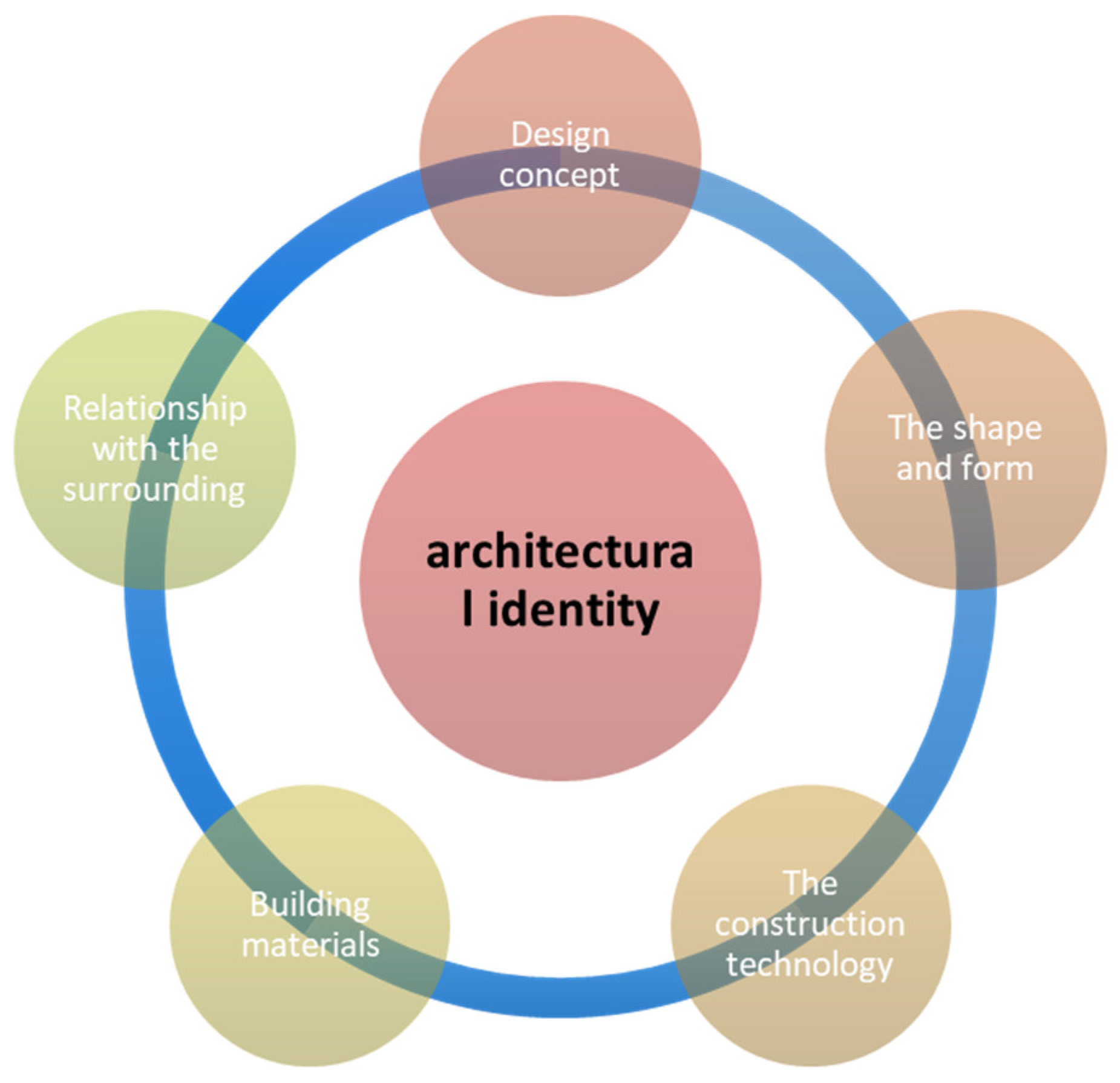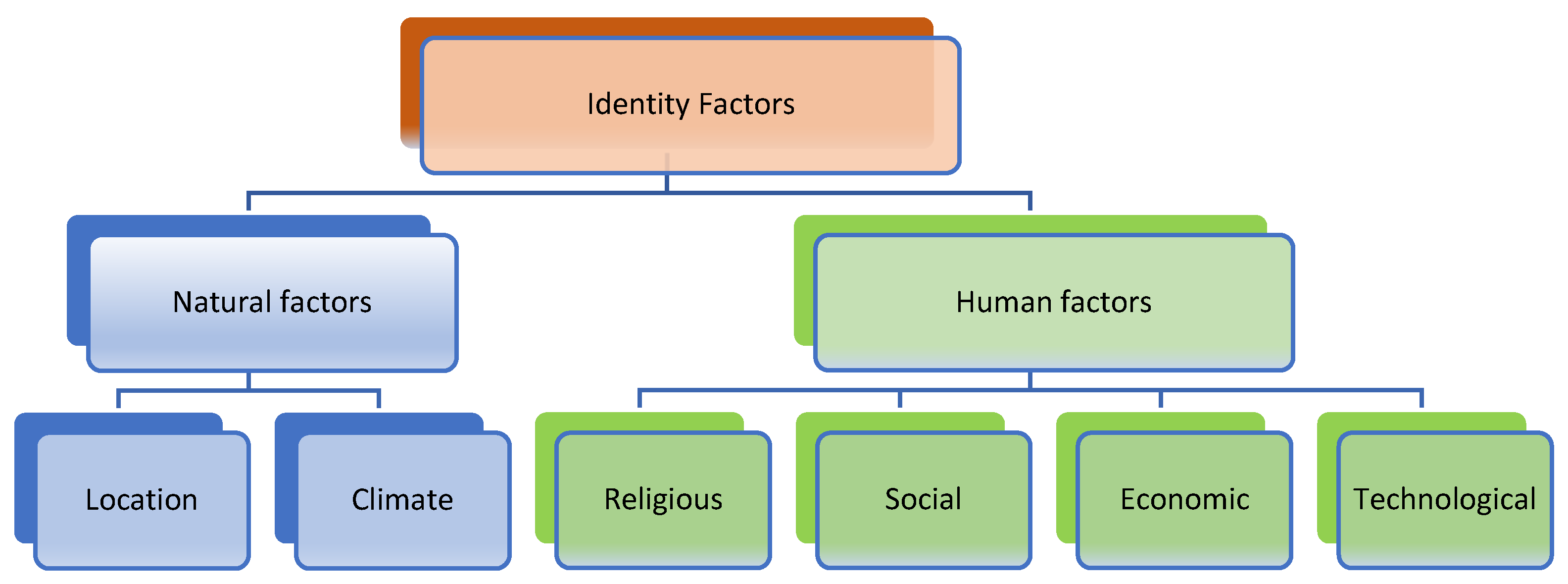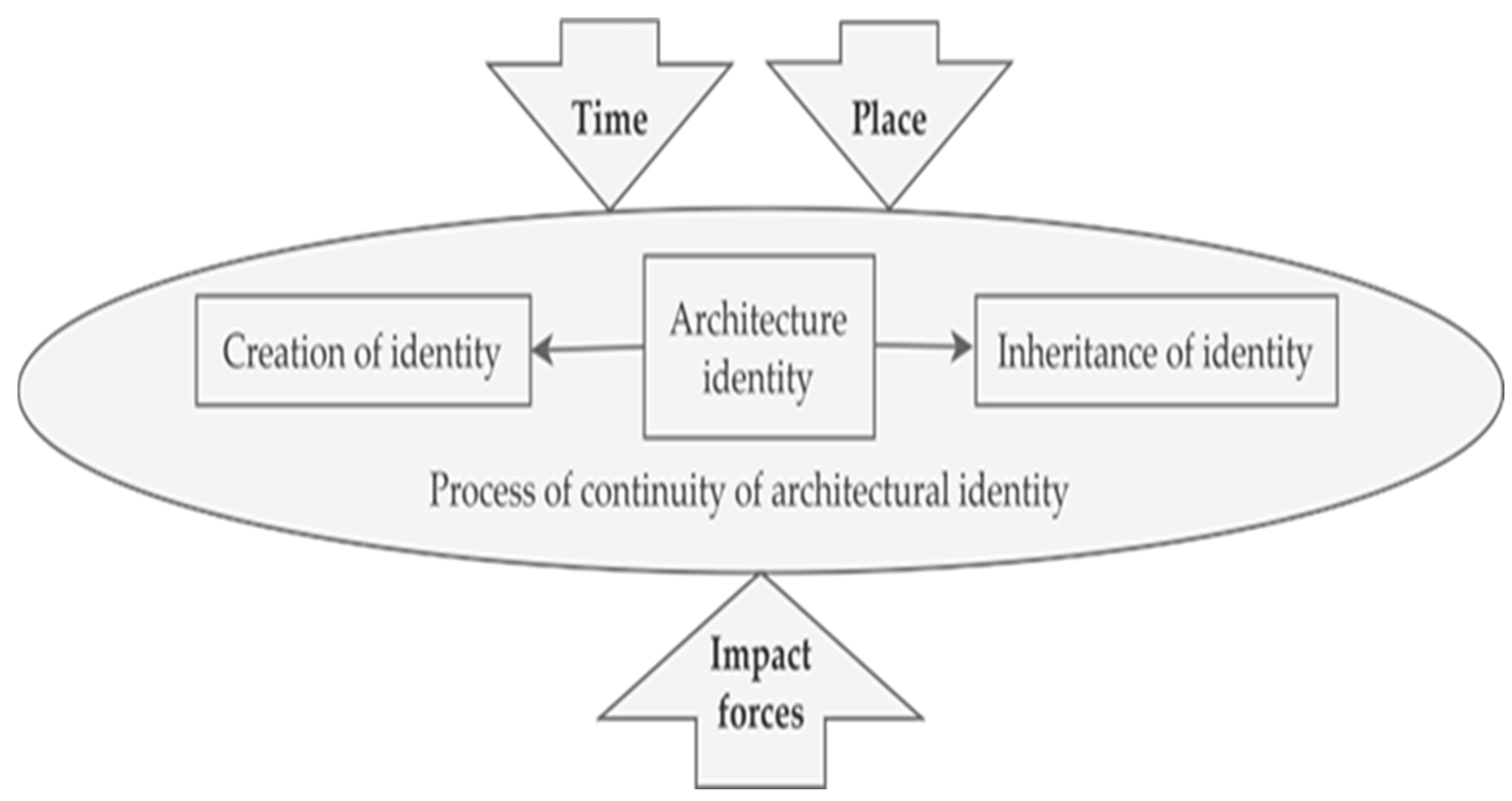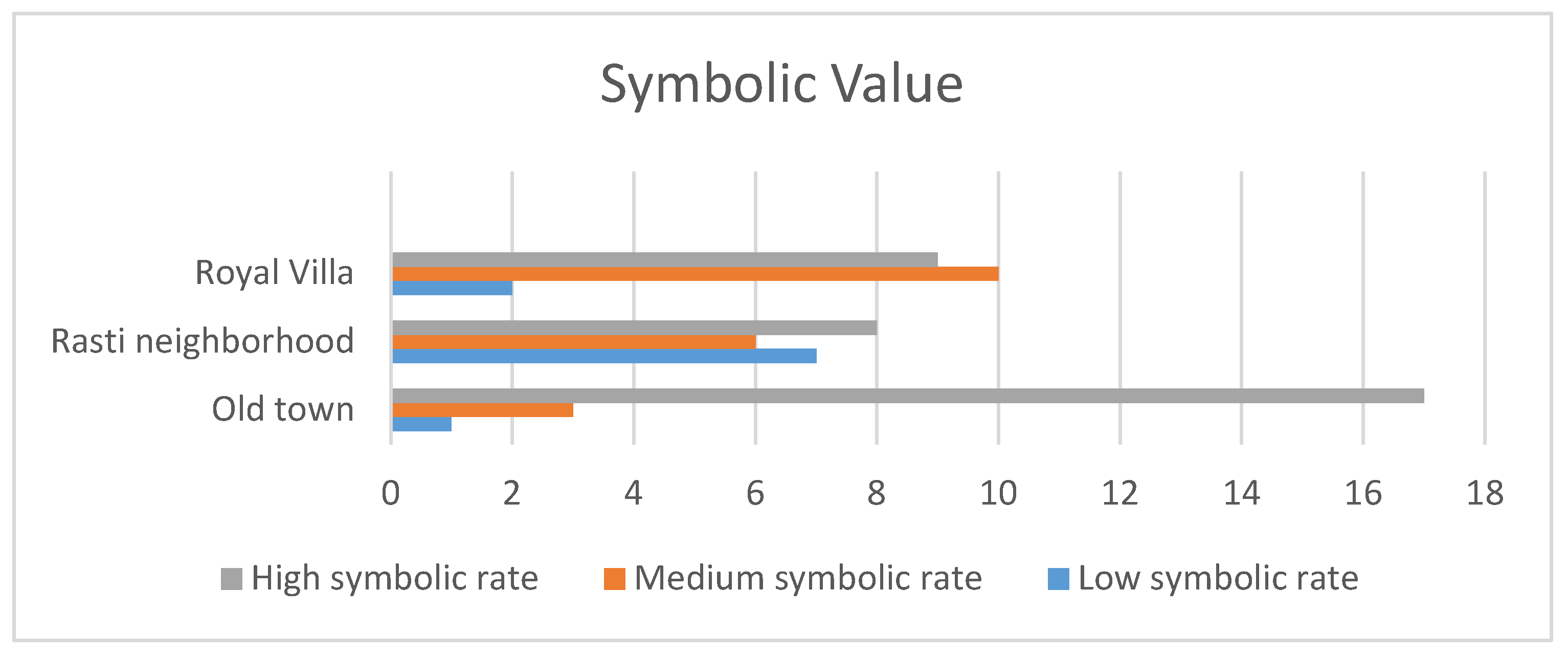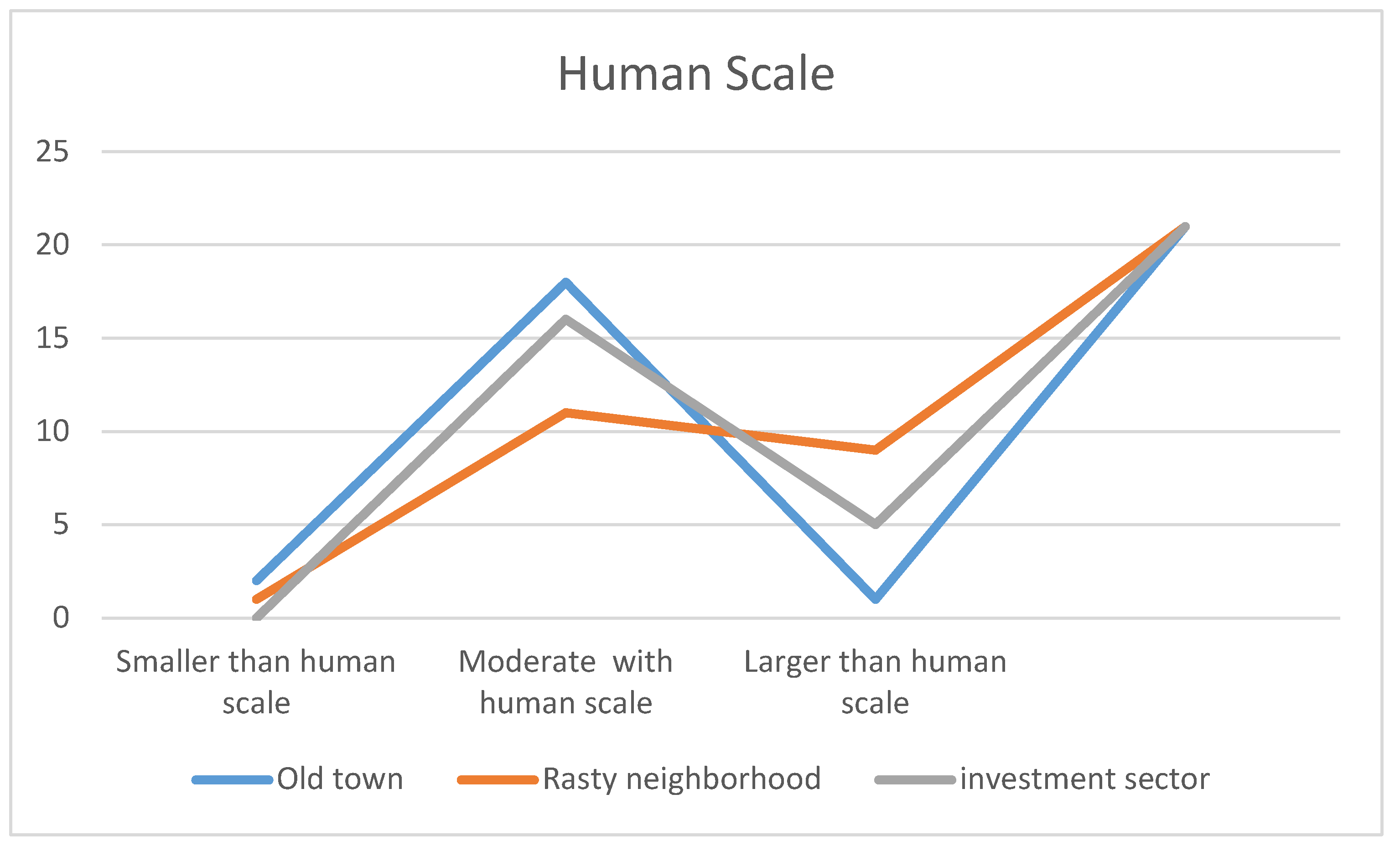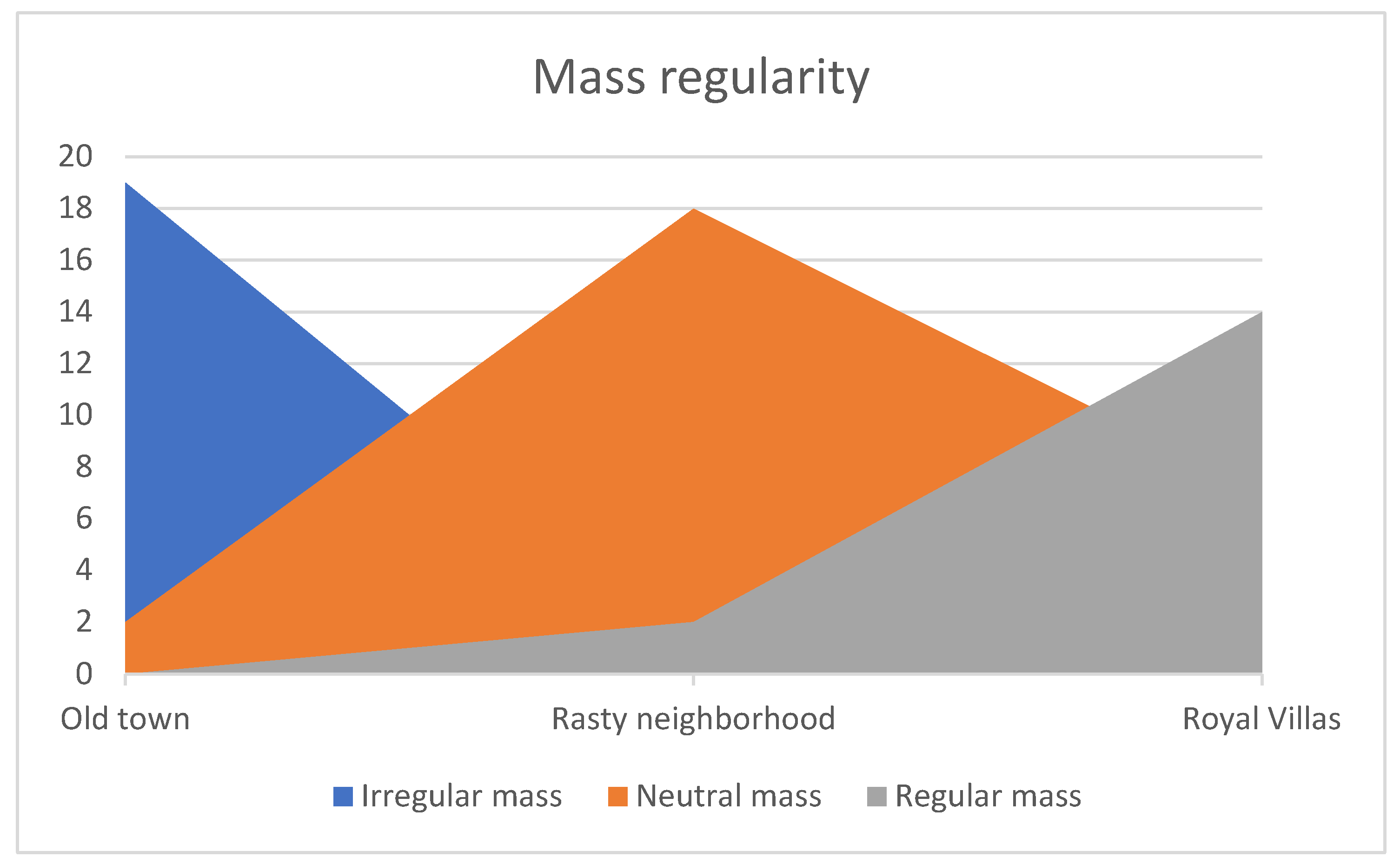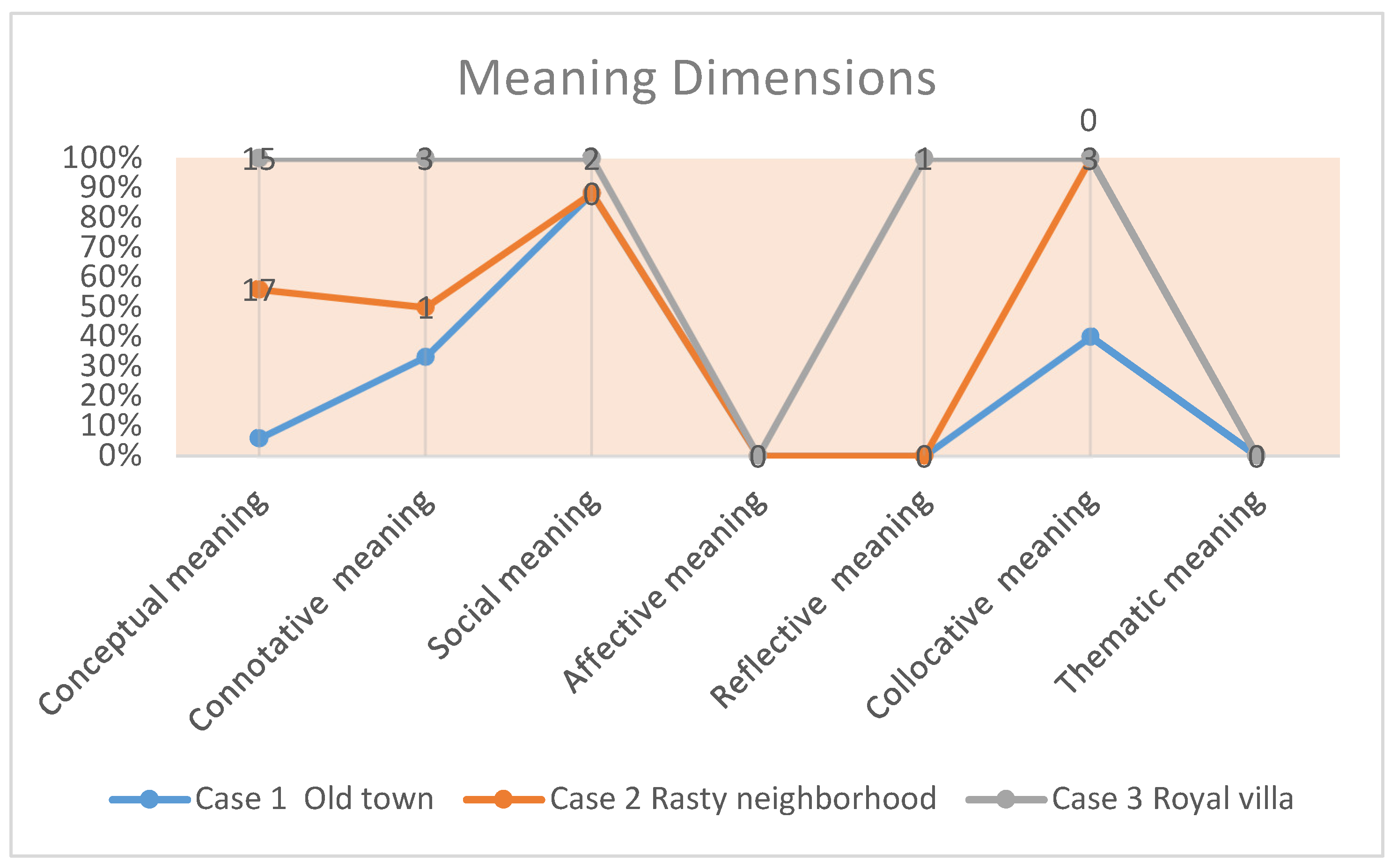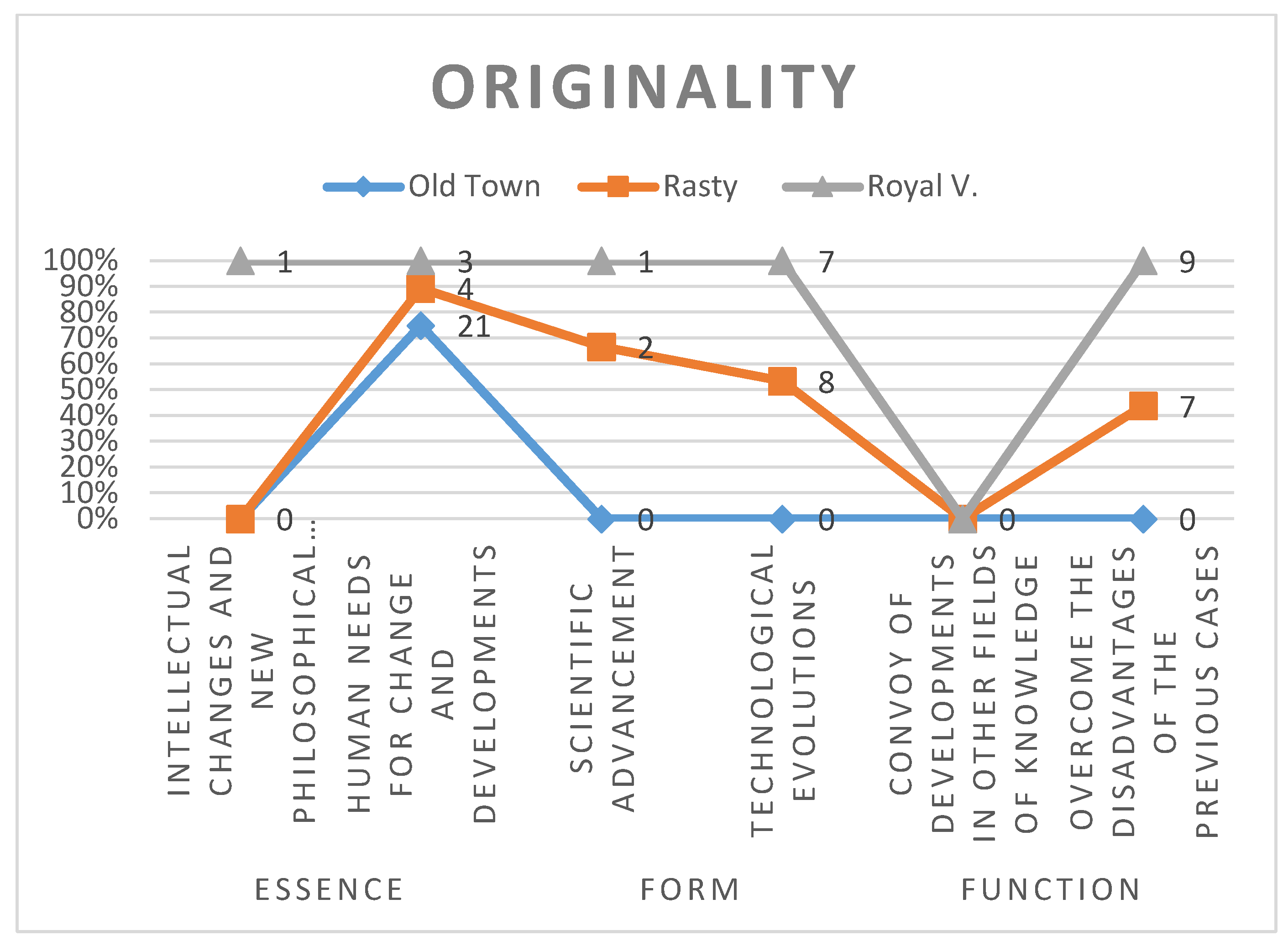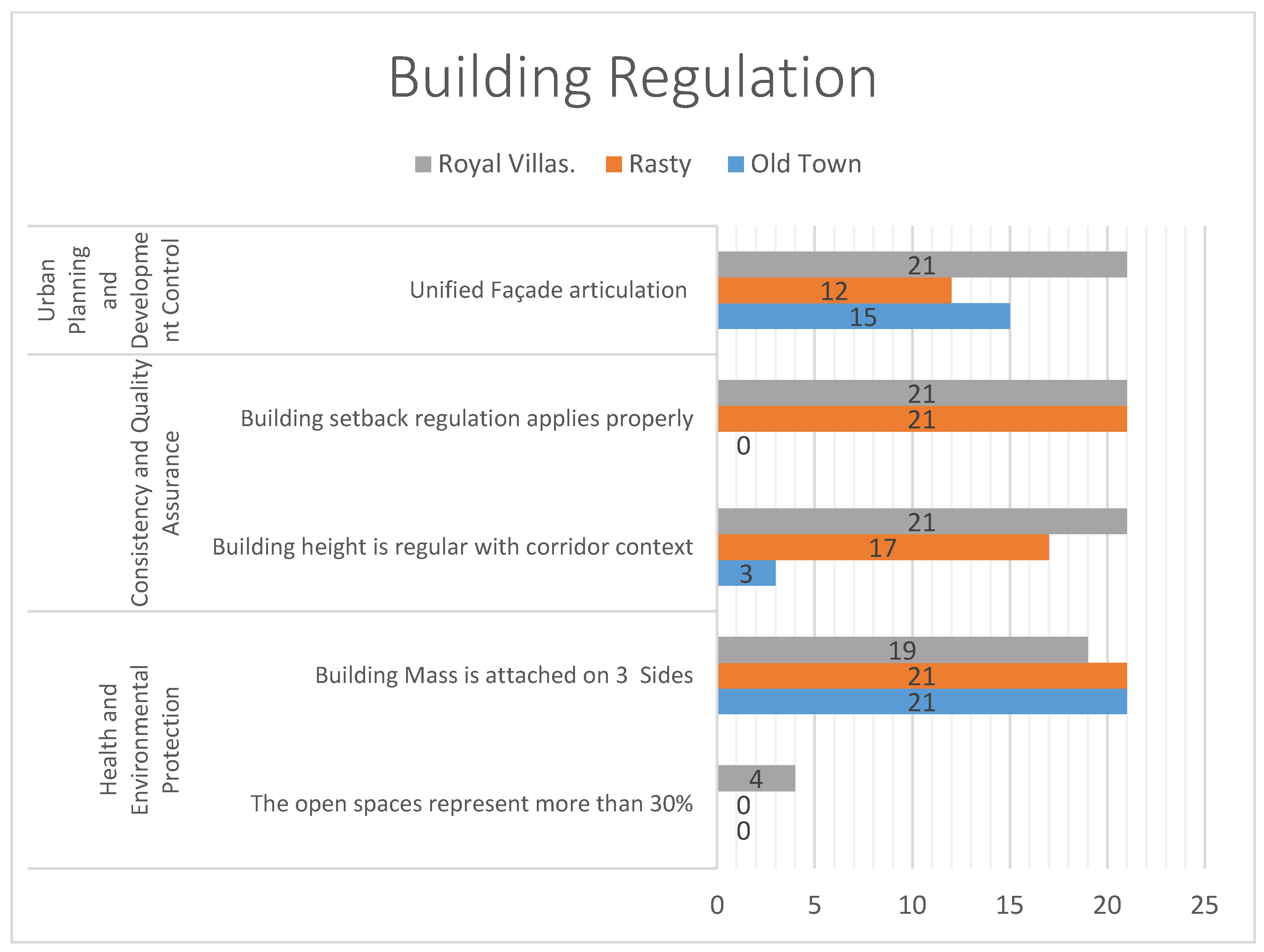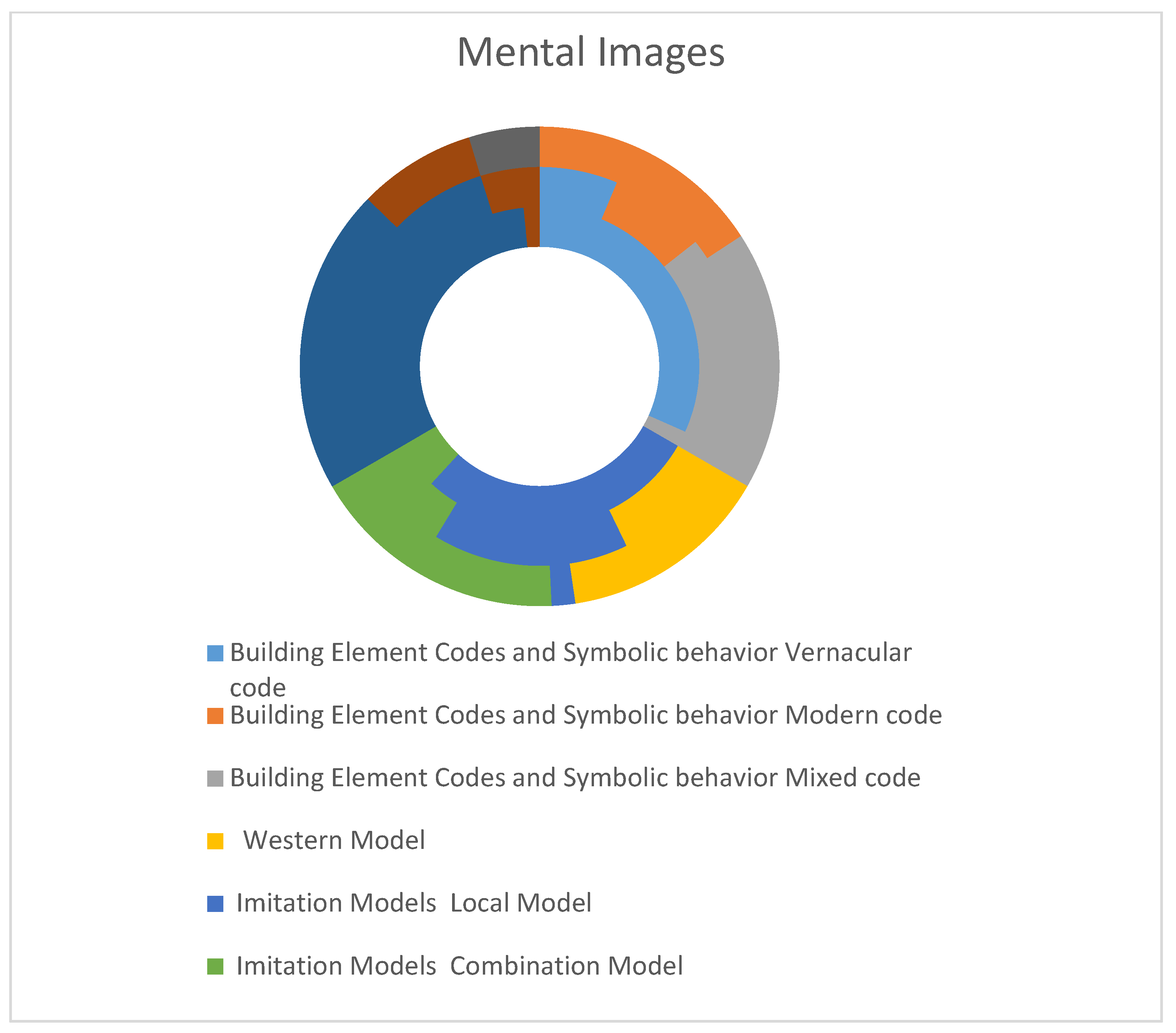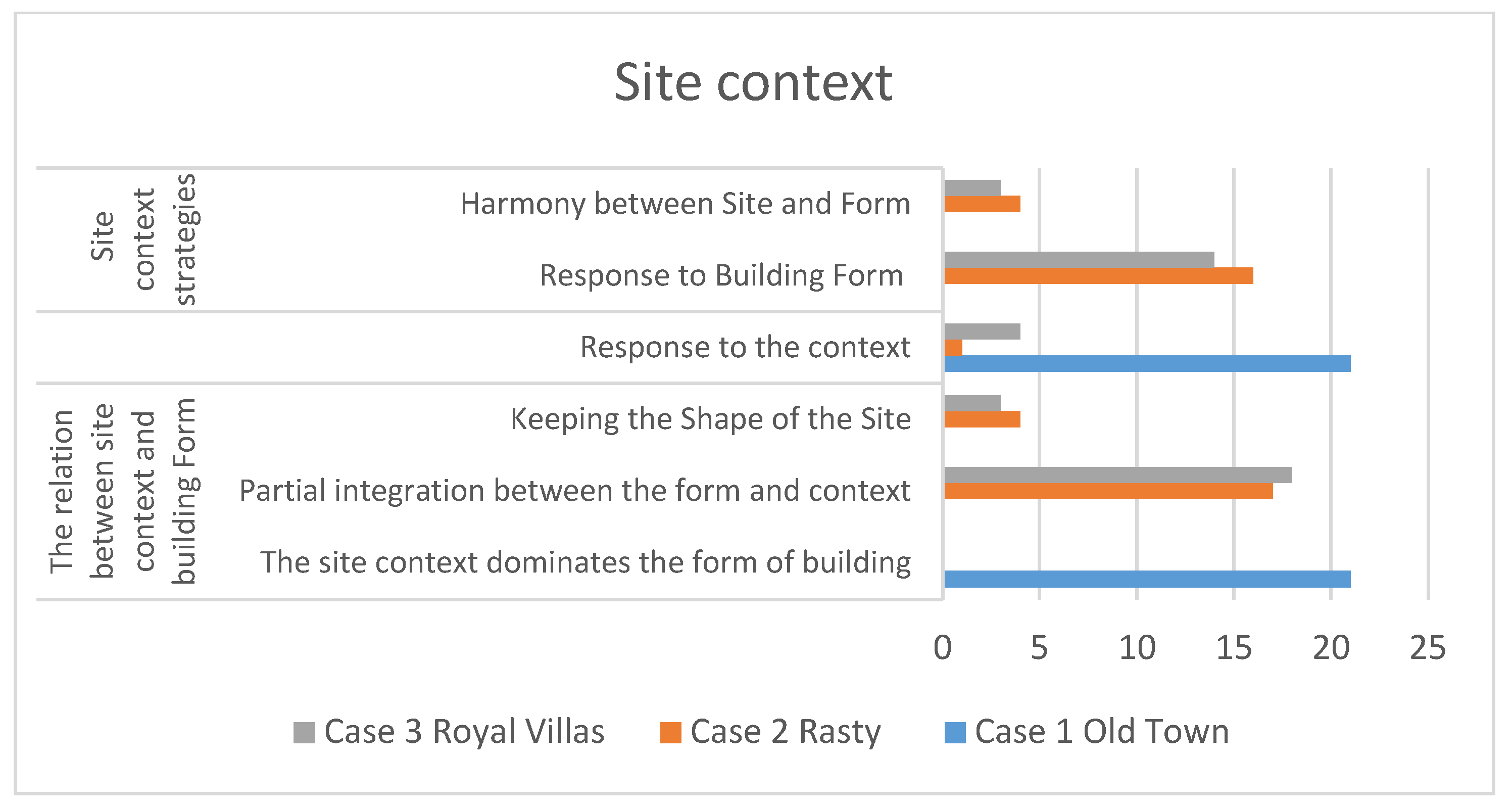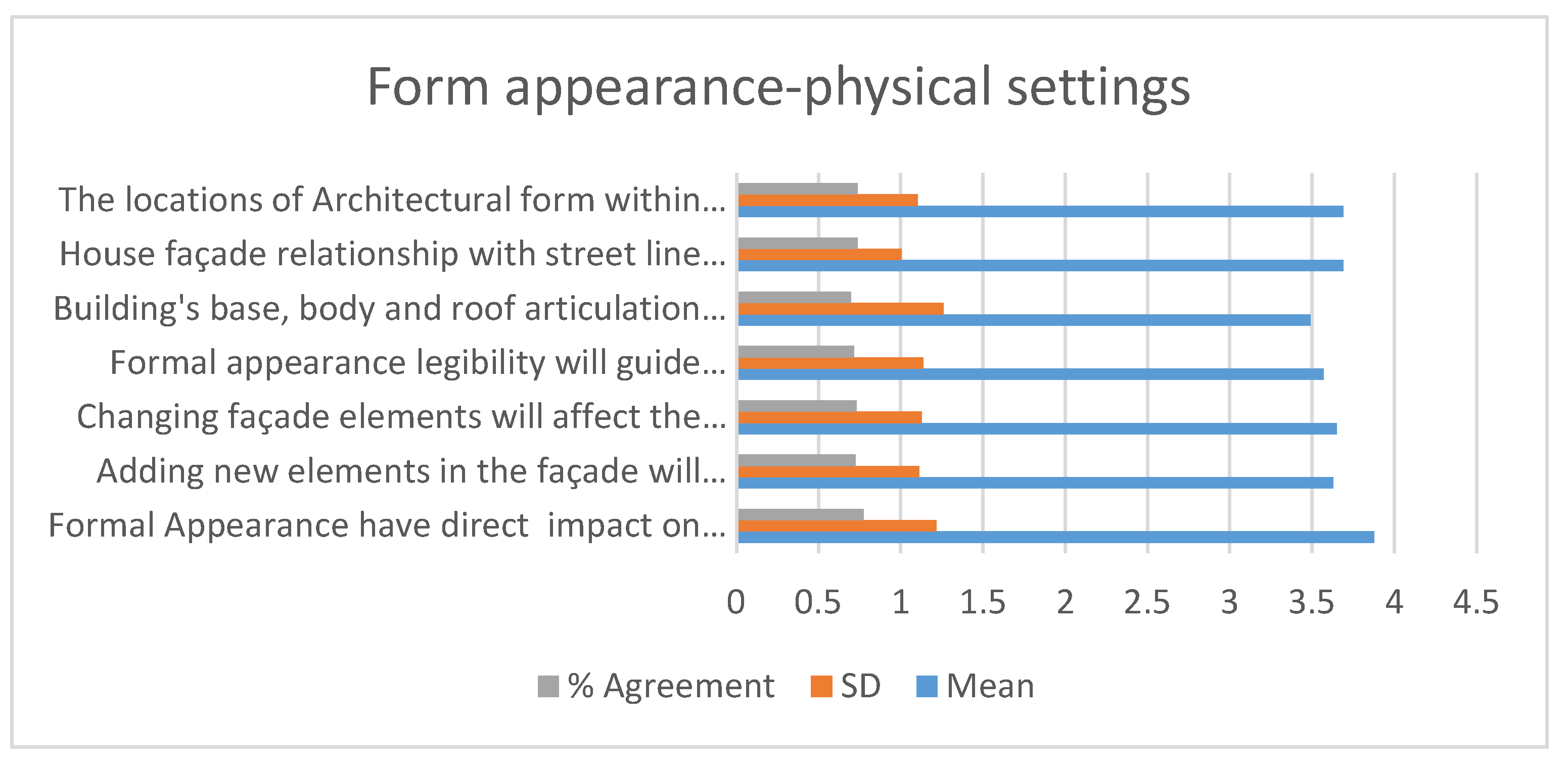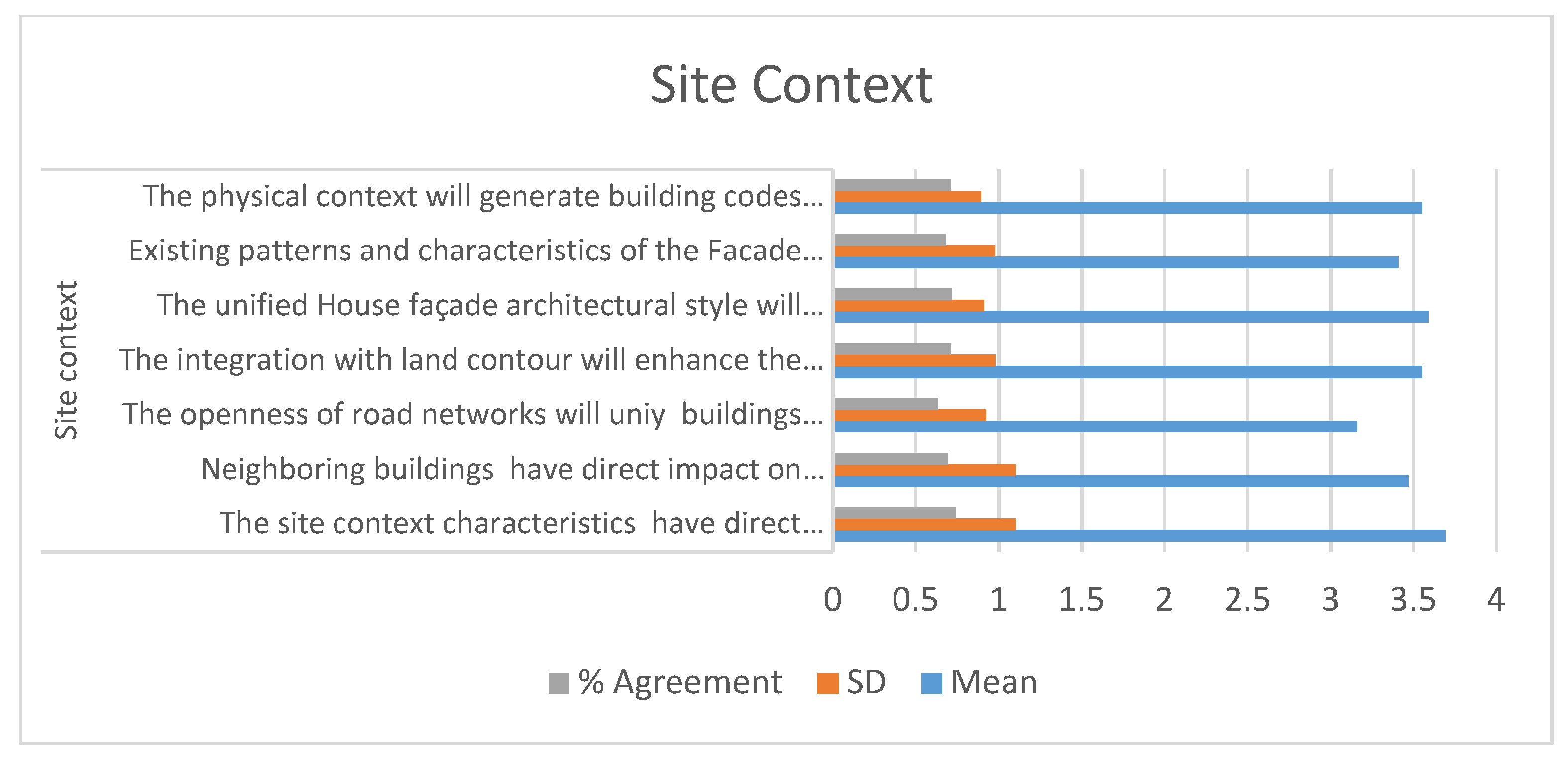1. Introduction
Recently, the concept of sustainability has emerged as a creative approach to combine the ordinary solutions of previous generations with an integrated, holistic approach that positively impacts a building’s life cycle through the combination of architectural identity parameters and their impact on sustainable permanency. Sustainability in architecture is an important approach that has developed over time by applying available materials and technologies in different settings. It is a process to create a relationship between humans and their surroundings [
1]. In general, architectural permanency means “enduring presence or existence, continuance in the same condition or place” [
2]. It means to remain, endure, and continue as a sustainable approach in the community.
The idea of sustainability in architecture can be defined by two broad concepts. The first is to preserve natural resources, while the second is related to the safeguarding of place identity [
3]. Therefore, sustainability refers to the maintenance of environmental resources as well as the permanence of local identities.
Façades play an important role in creating the identity of a place. The arrangement of façade elements and their distinctive features generate symbols and signs that improve the cultural value of the place. Therefore, the physical image of identity would take variable frameworks across time and space, but understanding the meaning of identity is related to our perception of the architectural forms. Architectural identity does not only rely on the material composition and form of the building but is also linked to the concept of meaning, which represents a significant interaction of human values with spatial characteristics. The aesthetic value of façades is the seed of architectural identity towards new horizons in the built environment [
4,
5].
Researchers in the field of architectural identity have proposed several models to identify the main parameters that measure architectural identity; each study focuses on a direction of architectural identity through the proposition of some dimensions.
Relph, in his study Place and Placelessness, clarifies that place identity can be achieved through a model of three pillars, which are ‘physical setting’, ‘activities’, and ‘meanings’ [
6]. In this regard, Baper formulates a comprehensive framework, including the most effective properties of architectural identity, which are vocation of place, authenticity, symbolic function, process of continuity, privacy, diversity, and climate considerations [
7] (see
Figure 1).
For Mahdavinejad and Saadatjoo [
8], the most effective factors can be crystallized through essential architectural characteristics and physical concepts (see
Figure 2). These features can be classified as structural design ideas, building technology and materials, and relationships with the surroundings. The study illustrated the following issues as the most effective factors in shaping architectural identity:
The role of the design concept in forming contemporary identity.
The shape and form.
The construction technology.
The building materials as a path to contemporary architecture.
The relationship with the surroundings.
While Torabi and Brahman [
9] applied effective factors in shaping the identity of architecture, they suggested a model that included another parameter, which is the relationship with context, in addition to the shape and form of the building, the design principles, the materials, the temporal organization, the semantic organization, and the spatial organization (see
Figure 3). In parallel, Lambe and Dongre [
10] added context as an effective parameter for detecting architectural identity. Context refers to the tangible and intangible attributes of the surroundings that produce architectural cues. Hence, it is important to note that identities are situational expressions of impulsive procedures that play a significant role in creating architectural vocabulary. Hence, it is interesting to note that architectural identity has a comprehensive nature, referring to a set of unique and essential qualities that characterize an entity, whether physical or moral.
From another standpoint, Gloaguen [
11] explains that architectural identity covers formal appearance (the human way of thinking) as a way of identifying architectural originality plus the creative process (a building’s way of design) (see
Figure 4). The combination of these parameters will create an architectural identity.
On the other hand, Ali et al. [
12] focused on measurable elements of place identity. Their study proposed the fundamental components of a place that affect identity through three parameters, which are the environment, people, and the interaction between them. The collection of these parameters will guide toward a sense of identity in the place. Hence, it is important to note that interactions of various socio-political, socio-economic, and socio-cultural characteristics (that arise over time) will create different traditions, values, and norms within each community.
For AL-Zahrani and Abou Leila [
13], many influencing variables impact character, which is split into two categories: natural causes such as “temperature and the basic shape of the site” and “civilized” human factors such as religion, politics, and social factors (see
Figure 5).
In parallel, Khaznadar and Baper [
14] suggested a model that defines identity as a continuous process by combining two opposite perspectives (see
Figure 6). The first declares that architectural identity is inherited through generations, while the second approach believes that architectural identity can be constructed due to new technologies and scientific sightings. The two attitudes have two conflicting associations, in which each approach is affected by different factors and dimensions. The suggested model reveals that time and location within the geographical context are the two main factors in the development of the identity formula.
In conclusion, the suggested parameters in previous models can be conceptualized in a new framework that recognizes identities as situational expressions of the cultural process. The model includes two attitudes: the first sheds light on the differences between groups, while the second searches for similarities among them (see
Table S1).
4. Research Methodology
Due to the complexity of the topic, this study adopted a mixed methodology in which checklist factors are combined with a cross-sectional survey questionnaire. The checklist factor technique is the first step in dealing with research questions. Checklist factors are an assessment tool that lists the specific criteria for measuring identity parameters. It is a form that is used for recording data that are usually easy to extract in a useful manner and effective at registering identity parameters. On the other hand, qualitative questionnaires are a structured research methodology used to gain in-depth information about architectural identity. The ultimate goal is to develop a theoretical framework that includes the most effective factors in shaping architectural identity. Each parameter includes several sub-factors, which are assigned via a range of pertinent values to clarify the significant influence on the permanency of architectural identity.
Based on the evolution of Erbil City over different periods, three types of neighborhoods have been selected. The first category is related to the old town neighborhood, represented by cases in the Arab district–buffer zone of Erbil City; the second category is related to the regular neighborhood (Rasty district), which represents most of the ordinary neighborhood in Erbil City; and the third category is related to the new investment neighborhood (mostly constructed after 2003) with special characteristics of the investment sector neighborhood. A stratified method of sampling is selected for this study. This method is used when representatives from each subgroup are effectively embodied within the whole sample population (21 cases in each neighborhood). The rationale behind selecting three different neighborhoods is to explain the physical features of house façades over different periods of the city’s evolution as well as to ensure that a suitable range of city neighborhoods is tested.
For the data collection, three different neighborhoods (an old town neighborhood, a regular neighborhood, and an investment sector neighborhood) were selected using the qualitative case study method to provide an in-depth analysis of case studies from traditional to modern investment projects. In parallel, a structured questionnaire survey was applied after testing it through a pilot study on a group of 20 architects. The rationale behind the pilot study was to predict the response patterns of participants and make any required changes to our study. The survey was a self-administered questionnaire with multiple-choice questions in a Google Forms pattern distributed among a group of respondents. A total of 140 survey forms were distributed via Google Forms questionnaires (web-based questionnaires). A total of 76 filled-in questionnaires were returned and used for statistical analysis. The advances in technological online surveys support the idea of developing user-friendly web-based questionnaires.
The study area is linked to one of the oldest continuously inhabited cities in the world (Erbil City neighborhoods). The idea behind conducting quantitative research is to enhance research assumptions related to architectural identity phenomena. In this study, three types of analysis are applied: descriptive analysis, correlation analysis, and multi-regression analysis. Correlation and regression are used to describe the relationship between a study’s independent and dependent variables (correlation is used to measure association, while regression is used for prediction). In this study, quantitative research is conducted to test the study assumptions regarding the main effective parameters that affect the permanency of architectural identity.
The combination of two research methods (checklist factors and research questionnaires) increases the validity of our research and enhances the reliability of the analysis. It establishes a rational basis for developing the study’s core model of architectural identity. It is interesting to note that the theoretical framework is derived from previous architectural models and enhanced by a relevant literature review of the variables involved.
5. Results
After applying the checklist factors to local cases, the results indicate that each case has its own distinctive features. The old town neighborhood, the regular neighborhood, and the investment sector neighborhood are connected in terms of the permanency of architectural identity.
The multi-dimensional model consists of seven parameters, which are formal appearance–physical setting, meaning dimensions, originality, architectural language, building regulations, mental images, and site context. The model creates a sense of structure to measure the permanency of architectural identity.
5.1. Checklist Factors
5.1.1. Formal Appearance–Physical Settings
In terms of simplicity of building proportion, the observation and photographic documentation results show that simple proportion between the parts was the dominant feature in the old-town cases at a rate of 85.7%. Meanwhile, the moderate proportion within the human scale registered only three cases in the old town, eight cases in the Rasty district, and four cases in the Royal Villas neighborhood. It is worth mentioning that the complicated proportion feature was the dominant characteristic of most of the cases in both the Rasty district and the Royal Villas neighborhood, as clarified in
Table 1.
However, the results shown in
Table 2 indicate that the symbolic feature sub-factor is distributed among three possible values (low, medium, and high symbolic rates). The majority of cases in the old town have high symbolic rates (81%), followed by the Royal Villas (67%) (see
Figure 7). Despite differences in the three main neighborhoods in terms of period, quality, and unit sizes, symbolic values are recorded in the majority of cases. These results indicate that house façades in Erbil City focus on symbolic values despite the plurality of styles.
In terms of human scale, this study formulated three possible values for measuring this parameter, as follows: smaller than human scale, fit with human scale, and larger than human scale (see
Figure 8). Our study revealed that human scale as an elementary character is a common feature of most cases in Erbil City. Despite the differences between the three neighborhood zones, the fit-with-human-scale parameter recorded 71.4% of overall cases.
In parallel, the results explain that mass regularity has changed in the old neighborhood (as recorded in 90.4% of its cases) by using irregular mass, while most cases in the Rasty neighborhood were noted as having neutral mass and two-thirds of cases in the Royal Villas were recorded as having regular mass (see
Figure 9). These results indicate that the regularity of house façades has changed from irregular mass (as characteristic of traditional districts) toward regular house façades as a translation of Western style.
The observation and photographic documentation results indicate that the ratio of solid to void in façades has changed from mostly solid indoor-looking with small openings as a distinctive feature of traditional houses to large transparent openings (Western style) in new neighborhoods. It is interesting to note that these changes match new discoveries in material inventions, especially glass panel technologies as well as large-span openings.
In terms of architectural detail in façade design, our study reveals three imaginable values related to cultural, historical, and environmental contexts. The results indicate that most of the cases in the old town are related to historical context at a rate of 85.7%, while environmental context is the controlling factor in most cases in both the Rasty and Royal Villas districts. Hence, it is quite clear that environmental context affects the positivity of architectural detail in façade design.
The final sub-factor of the first parameter is related to the materiality of house façades. It includes three values, as follows: using traditional materials, using modern materials, and mixing traditional and modern materials. Recently, due to the importation of new cladding materials, a trend of mixing traditional materials (stone and brick) with new modern materials (Boardex, composite panels, and foam boards) has created a sense of material mixture. This mixture affects the appearance of house façades in the city. Our results indicate that more than two-thirds of house façades in both the Rasty and Royal Villas neighborhoods are now using new material mixtures which reflecting the mood of modernity.
5.1.2. Meaning Dimensions
Our study reveals that the meaning dimension is distributed into two categories. In traditional zones of the city, most of the cases in the old town emphasize social meaning, which refers to the cultural and social factors that influence the interpretation of architectural language. The old town examples (at a rate of 71.4%) contain a range of characteristics, such as social norms and cultural values. These values come from the arrangement of elements to produce architectural form, which is essential for effective communication. Therefore, social meanings categorize the cultural and social hints that affect the interpretation of architectural language. In parallel, the second category is related to conceptual meaning, which was recorded in both the Rasty and Royal Villas neighborhoods at a rate of 80.9% and 71.4%, respectively (see
Figure 10).
The second category is related to conceptual meaning (straightforward, literal, and clear meaning), which means that there are no hidden meaning dimensions to avoid any misunderstandings of the façade detail. The element is formed and defined using its constituent nature for a specific meaning. This type of meaning is observed in both the Rasty neighborhood (at a rate of 80.9%) and the Royal Villas neighborhood (at a rate of 71.4%).
5.1.3. Originality
The third parameter deals with three sub-factors, which are essence, form, and function. The results indicate that the originality of the old town is mostly related to essence through human needs for change and development, while form and function control most cases in the Rasty and Royal Villas neighborhoods. These results are an indicator that the concept of originality in the modern era is connected with form and function more than with essence, whereas the cases in the old town strongly relate to essence as the base of their originality (see
Figure 11).
5.1.4. Creative New Expression Languages
The measurement of the fourth parameter is related to four sub-factors: building element codes, symbolic behavior, imitation models, and cultural boundaries (see
Figure 12). In terms of building element codes, the observation and photographic documentation results indicate that most of the traditional cases in the old town are related to the vernacular code at an average of 95.2%, whereas the modern code is the distinctive feature of most cases in both Rasty and the Royal Villas.
It is interesting to note that the expression language (categorization of signs) is distributed in three groups. Generally, signs are repeated in only 8 cases, while symbols are repeated in 26 cases, and indexes are repeated in 28 cases. This is a clear indication that the architectural language in the city has symbolic features in most cases.
5.1.5. Building Regulations
Another effective parameter is related to building regulations through four sub-factors: health and environmental protection, consistency and quality assurance, urban planning and development control, and safety and structural integrity (see
Figure 13). Our study reveals that open spaces in house layouts rarely reach 30% of the plot area; only four cases are recorded in the Royal Villas. This is an extraordinary consequence in terms of health and environmental protection. However, the regularity of building height as a factor of consistency and quality assurance shows that most cases in Rasty and the Royal Villas comply with building height regulations. It is worth mentioning that setback regulations are applied properly in all cases. This result is an obvious hint that building regulations are properly applied in new neighborhoods and totally neglected in old districts due to the lack of strict building regulations during that period.
5.1.6. Mental Images
Mental images play an operative role in measuring architectural identity since the main function of mental imagery is to represent and manipulate visual information through visual codes and cues. In this regard, mental images can be measured through the following sub-factors (see
Figure 14): building element codes and symbolic behavior, imitation models, and cultural boundaries. Our results show that building element codes and symbolic behavior in the old town are mostly related to vernacular codes at a rate of 95.2%, while mixed codes are the most frequent feature in the Rasty district at a rate of 57.1%, and modern codes and mixed codes control most cases in the Royal Villas.
On the other hand, the imitation models in the old town focused on the local model at a rate of 85.7%, while the Western model recorded 42.8%, followed by 52.3% for the combined models in the Royal Villas neighborhood. It is interesting to note that most cases in the three neighborhood districts concentrated on local frontiers as the best scenario for cultural boundaries.
5.1.7. Site Context
The last parameter for measuring architectural identity is related to the site context through two factors: the relation between site context and building form and site context strategies. Our results show that site context dominates the form of buildings in all cases in the old town neighborhoods (see
Figure 15), while partial integration between form and context is the dominant feature in the Rasty neighborhood at a rate of 80.9%, followed by a rate of 85.7% in the Royal Villas. However, site context strategies achieved a full rate of response to context in the old town, and a response to building form at a rate of 76.2% in the Rasty neighborhood and 66.7% in the Royal Villas neighborhood.
5.2. Quantitative Analysis
The second part of this analysis will focus on the questionnaire results. It aims to measure the impact of effective parameters on the permanency of architectural identity. Accordingly, the following analysis has been applied:
5.2.1. Descriptive Analysis
The results from the statistical analysis depicted in (
Figure 16), show that most of the respondents agree that formal appearance has a direct impact on architectural identity at a rate of 77.55%; however, 80% of respondents believe that the moral meaning dimension is a sentimental factor in shaping the permanency of architectural identity. They believe that architectural Form should make its function possible and transfer its meaning to the users.
Moral Meaning Dimension
The results show that 80% of respondents agree that architectural form should transfer its meanings. While only 73.06% believe that symbols have connotative meanings within architectural identity, 72.24% agree that the conceptual meaning of architectural identity is generated based on cultural–social values, and merely 71.43% of respondents agree that the adaptation of façade elements will affect its meaning dimensions in a cultural context. In light of the above results, the study of this parameter (moral meaning dimensions) matches the respondents’ perspective.
Originality
In terms of originality, the results indicate that more than two-quarters (72.24%) agree that using local architectural details in building façades will guide towards originality. In parallel, 71.84% of respondents think that original symbols can represent deeper meanings, and 71.24% assert that using local architectural details in building façades will guide towards originality.
Creative New Expression Languages
The results show that 79.18% of respondents agree that the efficient use of local materials in building house façades will enhance the expression concept of locality, whereas only 76.73% believe that the technological developments experienced in the field of architecture have changed the thought and production of architectural forms, and 74.29% argue that the expression language of architecture is created through the combination of local architecture melded with available technology and is related to traditional representation tools mixed with technological ones.
Building Regulations
The results show that 68.98% of respondents agree that building regulations have a direct impact on architectural identity by reducing the complexity of elements in house façades, whereas 70.20% agree that form solidity regulations have an effect on the symbolic expression of architectural identity, and only 68.98% think that using large transparent elements in house façades will change the solid mass locality of Erbil City’s architectural identity. It is interesting to note that there is a common agreement among respondents that applying buffer zone building regulations in the old sectors of the city will enhance the sense of belonging within architectural identity.
Mental Images
Based on the results, approximately three-quarters of respondents agree that traditional language is a vehicle for memory and a generative system that stores experience. While 72.65% agree that mental images of Erbil’s citadel are spatial images that are transformed by spatial memory, only 71.84% believe that Erbil City’s cultural heritage establishes a three-dimensional language between individuals and the built environment through the old alleys, serving as mental imagery that enables the reactivation and manipulation of internal representations.
Site Context
The quantitative results display that 77.14% of respondents agree that site context characteristics have a direct influence on the permanency of architectural identity, followed by 73.88% who agree that neighboring buildings (as physical elements of site context) have a direct impact on architectural identity. Meanwhile, more than two-thirds of respondents agree that the unified house façade architectural style, the openness of road networks (as physical elements of site context), and the existing patterns of the façade fabric can provide meaning and promote continuity between the building and its local context (
Figure 17).
5.3. Reliability Statistics
The reliability of the questionnaire is designed to give the same results when repeated several times. Cronbach’s alpha is used to measure the reliability of the questionnaire, and its values are considered statistically acceptable if they are equal to or greater than 0.60.
Table 3 shows the value of the reliability coefficient (Cronbach’s alpha) for all items. The value of the Cronbach’s alpha coefficient was high (0.954). This is an indication that the reliability coefficient of the questionnaire is high and acceptable in terms of statistical analysis (see
Table 3).
5.4. Correlation Analysis
After confirming the reliability of the questionnaire, a correlation analysis was applied to recognize the relationships between the independent variables and their impact on the permanency of architectural identity. The Pearson product-moment coefficient correlation results in
Table 4 reveal that the strongest relationship is related to the mental images parameter with an (r) value of 0.855 at
p < 0.01, followed by the building regulation parameter (r = 0.831 at
p < 0.01), then creative new expression languages (r = 0.759 at
p < 0.01), the site context parameter (r = 0.731 at
p < 0.01), moral meaning dimensions (r = 0.678 at
p < 0.01), and, finally, formal appearance (r = 0.500 at
p < 0.01). These results identify the positive correlation between the independent variables and their impact on this study’s dependent variable. Hence, the results mentioned above decisively prove that the suggested model factors have a crucial impact on the permanency of architectural identity. This means that the suggested model parameters can easily measure the identity of any specific place and time through theoretical framework dimensions. These dimensions are applied to different façade articulations to generate symbols, which are a powerful tool for identifying a specific architectural tendency (see
Table 4).
5.5. Regression Analysis (Best Model)
Regression analysis is applied to make a prediction about the dependent variable (permanency of architectural identity) based on its covariance with the independent variables. Accordingly, an equation will provide the most accurate prediction of the effective factors that affect the permanency of architectural identity.
The best model is presented for the permanency of architectural identity in Erbil City neighborhoods by determining the combined effect of the independent variables, as follows: (1) mental images, (2) originality, and (3) building regulations, as indicated in
Table 5.
Table 5 highlights the results from the multiple regression analysis. The beta values indicate the unique contribution of the three main variables and formulate the final equation of the model, which is as follows:
Therefore, the R
2 for this model is 0.805, indicating that mental images, originality, and building regulations explained 80.5% of the variation toward the permanency of architectural identity(see
Table 5). These results reveal that the “mental images” parameter is the most influential in interpreting the permanency of architectural identity because every unit of change in this parameter is associated with a 47.7% change in the endurance of architectural identity. It is followed by the building regulation parameter at a rate of 25.3% and the “originality” parameter at 21.6%.
6. Discussion
The measurements of architectural identity are a complicated scenario that requires the articulation of façade elements to produce cues and signals to generate architectural identity. In this regard, scholars have identified numerous models to define the main parameters that affect the creation of architectural identity. Previous related studies identified the most effective features that preserve the continuity of the self. Starting from Relph’s suggestion that identity can be measured through physical settings, activities, and meanings [
6], the combination of relevant studies in one framework was the first contribution of this study.
Physical settings and meaning dimensions were the key variables that researchers tried to measure [
6,
7,
8]. Then, the relationship with context was applied as an additional factor in measuring architectural identity [
9,
10].
The study results reveal that the proposed framework for measuring architectural identity can be classified as follows:
Formal appearance–physical settings [
15,
18]:
Simplicity of building proportion.
Symbolic features.
Human scale.
Mass regularity.
Solid-to-void relationship.
Vernacular architectural details.
Materiality.
Meaning dimensions [
13,
19,
23]:
Conceptual meaning.
Associative meaning.
Architectural language [
27,
28]:
Building element codes.
Symbolic behavior.
Imitation models.
Cultural boundaries.
Building regulations [
13,
29,
30]:
Health and environmental protection.
Consistency and quality assurance.
Urban planning and development control.
Safety and structural integrity.
After applying the suggested model to be checked by experts in the field of architecture through a detailed questionnaire, a new refined theoretical framework with three parameters (mental images, originality, and building regulation) is generated (see
Figure 18). The new framework is another contribution of this study that measures the façade design’s characteristics, under the umbrella of architectural identity, towards new horizons in the built environment. The arrangement of façade elements and their distinctive features guide and provide identity to a place. The model creates a sense of structure to measure the permanency of architectural identity.
